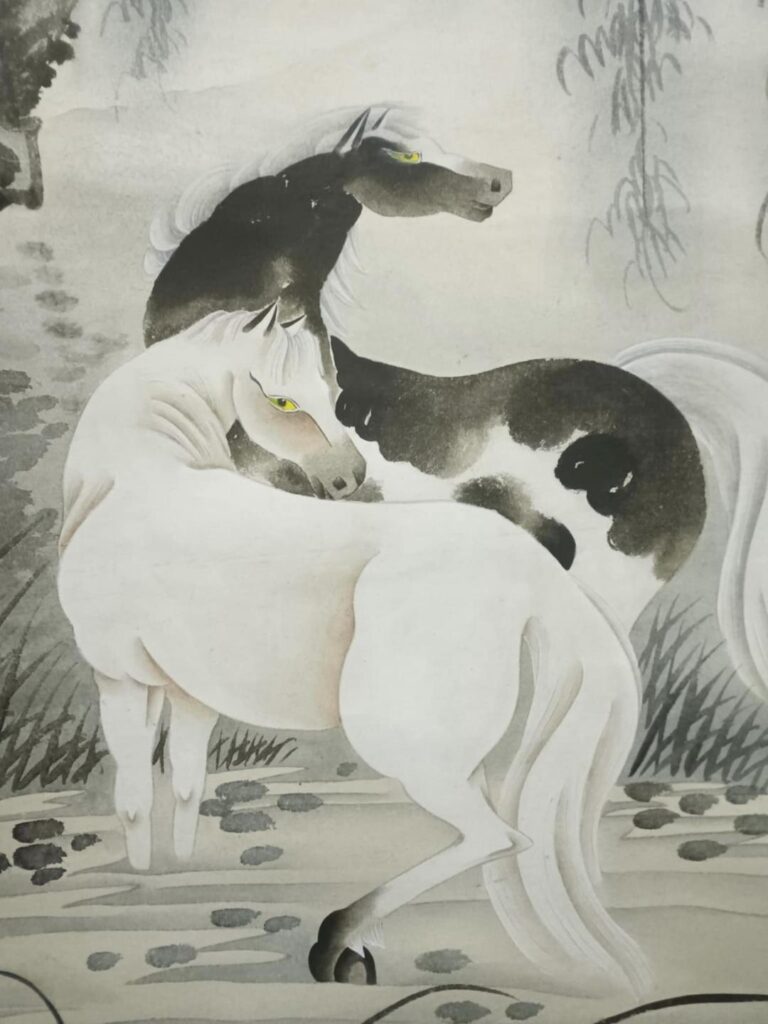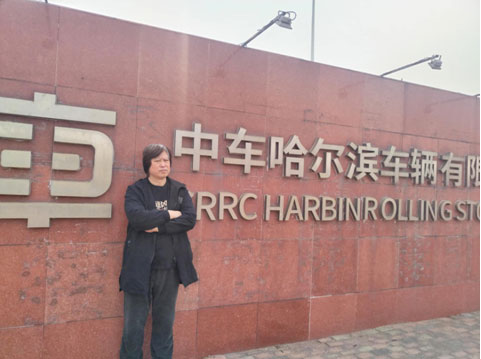
Ma Yongbo 马永波 purchased this painting in Harbin’s Chinese Baroque Cultural Street also known as Lao Daowai (老道外), and gifted the ‘Two Horses’ from himself to Helen Pletts 海伦·普莱茨 , 15th April 2025.
A willow uses its soft green tresses
to tickle its own reflection in the water
A silver stream listens to itself
its garbled stories will gradually grow clear
In the dark soft mud beneath the water, walking clams
reveal their chubby, fleshy bodies
Two horses, one black, one white, stand dozing by the river
swaying gently, sometimes rubbing their shiny rumps
printing wavy barcodes on everything around them
In the distance, green mountains rise and fall softly in sleep
clouds stay motionless, holding back another rain
Everything dozes lightly, as sweet as breath in the ear
April 20, 2025, midnight
Response Poetry by Ma Yongbo 马永波
Response Poetry Translated by Ma Yongbo 马永波
春天的自在——给海伦 Freedom in Spring — For Helen 马永波
一棵柳树用柔软的绿色发丝
撩拨自己水中的倒影
一条银色小溪倾听着自己
它含混不清的故事会逐渐清晰
水底漆黑的软泥里,行走的河蚌
露出粉嘟嘟多肉的身体
两匹马,一黑一白,在河边站着打瞌睡
微微摇晃,有时摩擦着发亮的臀部
给周围的事物打上波动的条码
远处的青山在睡梦中轻轻起伏
云彩久久不动,忍住了又一场雨
一切都在浅睡,甜蜜如耳边的呼吸
2025年4月20日午夜
two soft horses of golden sunlight—for Yongbo 两匹柔软的金色阳光之马——致永波
together they are blazing in the bright street,
their hooves occasionally meeting in sparks.
Gold re-fashioning their soft forms;
light softly entering and re-entering their shapes.
How does a horse move silently
as a ribbon of stolen light?
What door is left ajar?
Without the dull fixings
they gently spin in softer air?
And every surface of glass shimmers,
clouds are left undefended.
They can neither grey, nor whiten;
the sun is the furnace keeper of two.
20th April 2025
Response Poetry By Helen Pletts 海伦·普莱茨
Response Poetry Translated by Ma Yongbo 马永波
两匹柔软的金色阳光之马——致永波 马永波 译 two soft horses of golden sunlight—for Yongbo
它们一同在明亮的街道上燃烧,
它们的蹄子偶尔碰撞出火花。
黄金重塑着它们柔软的身形;
温柔的光反复进入它们的轮廓。
一匹马如何无声地移动
像一条偷来的光带?
是什么样的门虚掩着?
没有笨重的羁绊
它们在更柔软的空气中轻轻旋转?
所有玻璃的表面都在闪烁微光,
云朵卸下防备。
它们既不变灰,也不变白;
太阳为它们两个守护着熔炉。
2025年4月20日
Detail of a Painting : Two Horses by Hai Weng 海翁 (private collection)
Zhou Yukuan, known as Hai Weng, 海翁 , also known as the owner of Lingyun Pavilion, is a famous painter. Born in 1936 in an artistic family in Leshan City, Sichuan Province, he was influenced by his father since childhood and loved painting. He first studied under Feng Guanfu, Zhu Peijun, Li Zhonghai and other masters, and later entered the China Calligraphy and Painting Correspondence University for further study and has a considerable foundation in Western painting. He benefited a lot from the guidance of masters such as Huang Runhua and Yao Zhihua.
Hai Weng is diligent and thoughtful, pays attention to his own literary and artistic cultivation, and explores techniques. He is calm and honest, and does not seek vanity. He has worked hard in the field of art for many years, deeply studied traditional techniques and theories, and his imitations of the works of Ming and Qing masters are almost indistinguishable from the original. He gained insights from traveling around Bashan, Shushui, and the north and south of the Yangtze River, thus melting the essence of Chinese and Western plastic arts into one furnace, and using the aura of nature as a blueprint to cast his own style of works.
Hai Weng is good at painting landscapes with ink and colour. His conception is ingenious and his interest is quiet. He is a model of poetry in painting and has a considerable bookish air. His works are bold and delicate, with majestic mountains and flowing clouds and mist. The colours are bright and not vulgar, and he uses the landscape of absorbing and portraying all things to express his rich emotional world. He uses ink in a solemn and profound way, and his brushstrokes are smooth and free. There is both coarse and fine. He has both the lush and rigorous traditional techniques and the texture and novelty of Western paintings. He expands his artistic language with the combination of Chinese and Western techniques to express the charm of nature, which is very intriguing.
His works have won awards in national and international exhibitions dozens of times, and have been collected by some art galleries, museums, and memorial halls. In recent years, his works have been exhibited many times in Chengdu, Beijing, Guangzhou, Hong Kong, as well as Taiwan, Japan, and Malaysia. Dozens of news organisations such as Chengdu Evening News, Sichuan Daily, China Art, Collectors, Sichuan TV, and Voice of the Strait have introduced him in special topics. His works and biography have been included in dozens of picture albums and dictionaries such as “Selected Chinese Paintings and Calligraphy”, “Contemporary World Celebrities”, and “World Chinese Art Expo”, and have also been selected by many websites such as “China Federation of Literary and Art Circles Painting and Calligraphy General Network” and “Tianfu Hotline”.
Mr. Hai Weng is currently an international member of the Chinese Artists Association. He has been appointed as a painter, professor, art consultant, honorary president, and honorary principal by dozens of associations, art academies, and competition organizing committees at home and abroad, including the Chengdu Artists Association, Chengdu Elderly Calligraphers and Painters Association, Bingxu Jinshi Painting and Calligraphy Research Association, and Beijing Haitian Art Center International UNESCO Chinese Painting Research Association.
Ma Yongbo

photograph: Ma Yongbo April 2025, Harbin, China.
except from “Introducing Ma Yongbo” by Pat Nolan, The New Black Bart Poetry Society, August 2024
“Poet Ma Yongbo was born in 1964 in Heilongjiang Province, China. As a poet, he is representative of Chinese avant-garde poetry. He is also a leading scholar in Anglo-American postmodernist poetry. Since 1986 Ma has published over eighty original works and translations. He is a professor in the Faculty of Arts and Literature, Nanjing University of Science and Technology. His studies centre around Chinese and Western modern poetics, post-modern literature, and eco-criticism. His translations from English include works by Walt Whitman, Emily Dickinson, Ezra Pound, Wallace Stevens, William Carlos Williams, John Ashbery, Henry James, Herman Melville, and May Sarton among others. Notably one of Professor Ma’s early projects was the translation of Up Late, American Poetry Since 1970 (1987) edited by Andrei Codrescu.https://thenewblackbartpoetrysociety.wordpress.com/2024/09/06/introducing-ma-yongbo/
Helen Pletts

Helen Pletts, 2024, near Cambridge, in her garden which is also the subject of much of her poetry.
“Helen’s very personal poetry reveals her strong connection to the natural world while also laying herself open emotionally. She writes with a thoughtful, mesmerising delicacy on love and death, on joy and need, illness and exhaustion”. Kate Birch, Publisher, Ink, Sweat and Tears
